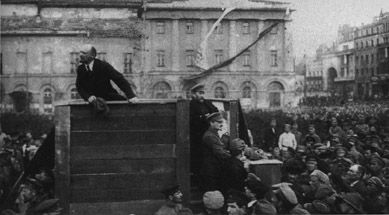Biography of Vladimir Lenin Communist revolutionary who helped found the Soviet Union.
Learn about the biography of Vladimir Lenin, communist revolutionary and founding father of the Soviet Union. He led the Bolshevik Revolution that put the communists in power in Russia

Biography of Vladimir Lenin
- Occupation: Chairman of the Soviet Union, Revolutionary
- Born: April 22, 1870 at Simbirsk, Russian Empire
- Died: January 21, 1924 at Gorki, Soviet Union
- Best known for: Leading the Russian Revolution and establishing the Soviet Union
Biography of Vladimir Lenin
Where did Vladimir Lenin grow up?
Vladimir Lenin was brought into the world in the city of Simbirsk in the Russian Realm on April 22, 1870. His original name was Vladimir Ilich Ulyanov. Lenin’s folks were both knowledgeable and his dad was an educator. Growing up Lenin went to class and was an amazing understudy. He additionally partook in the outside and playing chess.
When Lenin was sixteen years old, his father died. This made Lenin angry and he said he no longer believed in God or the Russian Orthodox Church. A year later, Lenin’s older brother Sacha joined a revolutionary group that planned to assassinate the Tsar (the Russian monarch). Sacha was caught and was executed by the government.
Becoming a Revolutionary
Lenin continued with his education at the Kazan University. While at university he became involved with politics and revolutionary groups. He began to study Karl Marx and became convinced that Marxism was the ideal form of government. At one point he was arrested and kicked out of the university, but he was later allowed to return. After graduating he worked as a lawyer.
Exile from Russia
Lenin continued his work as a revolutionary. He moved to St. Petersburg where he quickly became a leader among the Marxists. He constantly had to hide from the police and government officials as spies were everywhere. Eventually, Lenin created his own group of Marxists called the Bolsheviks.
In 1897, Lenin was arrested and exiled to Siberia for three years. Upon his return in 1900 he continued to foster revolution and push Marxism. However, he was banned from St. Petersburg and was under the watchful eye of the police. He spent much of his time over the next several years in Western Europe where he wrote communist papers and planned for the coming revolution.
World War I
When World War I broke out in 1914, millions of Russian workmen and peasants were forced to join the army. They were sent into battle under terrible conditions. They often had little training, no food, no shoes, and sometimes were forced to fight without weapons. Millions of Russian soldiers were killed under the leadership of the Tsar. The Russian people were ready to revolt.
February Revolution
In 1917, the February Revolution occurred in Russia. The Tsar was overthrown and the government was run by the Provisional Government. With Germany’s help, Lenin returned to Russia. He began to speak out against the Provisional Government. He said it was no better than the Tsarist government. Lenin wanted a government ruled by the people.
Bolshevik Revolution
In October of 1917, Lenin and his Bolshevik Party took over the government. Sometimes this takeover is called the October Revolution or the Bolshevik Revolution. Lenin established the Russian Socialist Federative Soviet Republic and he was the leader of the new government.

Lenin leading the Bolshevik Revolution
Photo by Unknown
Leader of the Soviet Union
Upon establishing the new government, Lenin made many changes. He immediately established peace with Germany and exited World War I. This was what Germany was hoping for when they helped him sneak back into Russia. He also took land from the rich landholders and divided it up amongst the peasants.
Russian Civil War
For the first several years of leadership, Lenin fought a civil war against the anti-Bolsheviks. He was a brutal leader. He stomped out all opposition, killing anyone who spoke out against his government. Like the Tsar before him, he forced peasants to join his army and also took food from the peasants to feed his soldiers. The civil war destroyed much of Russia’s economy and millions of people starved to death.
During the Russian Civil War, Lenin established War Communism. Under War Communism the government owned everything and soldiers could take what they needed from the peasants. After the war, with the economy failing, Lenin began the New Economic Policy. This new policy allowed some private ownership and capitalism. The Russian economy recovered under this new policy.
When the Bolsheviks finally won the civil war, Lenin established the Soviet Union in 1922. It was the first communist country in the world.
Death
In 1918, Lenin was shot in an assassination attempt. Although he survived, his health was never good again. Starting in 1922, he suffered several strokes. He finally died from a stroke on January 21, 1924.
Legacy
Lenin is remembered as the founder of the Soviet Union. His ideas on Marxism and communism have become known as Leninism. He was one of the most influential political leaders of the 20th century.
Interesting Facts about Vladimir Lenin
- Lenin’s birth city of Simbirsk was renamed Ulyanovsk in his honor (his birth name).
- In 1922 Lenin wrote his Testament. In this document he raised concerns about Joseph Stalin and thought he should be removed from office. Stalin, however, was already too powerful and succeeded Lenin after his death.
- He married fellow revolutionary Nadya Krupskaya in 1898.
- He took the name “Lenin” in 1901. This likely came from the River Lena where he was exiled for three years in Siberia.
- Lenin founded and managed the communist newspaper called Iskra in 1900.
read more : Biography of Kublai Khan
 The First Encyclopedia Your First Knowledge Home
The First Encyclopedia Your First Knowledge Home
